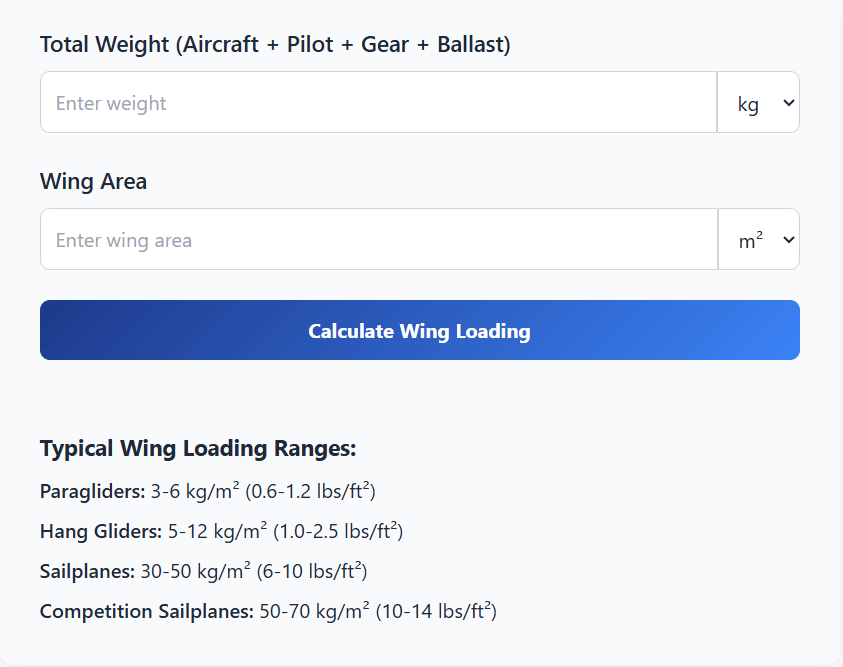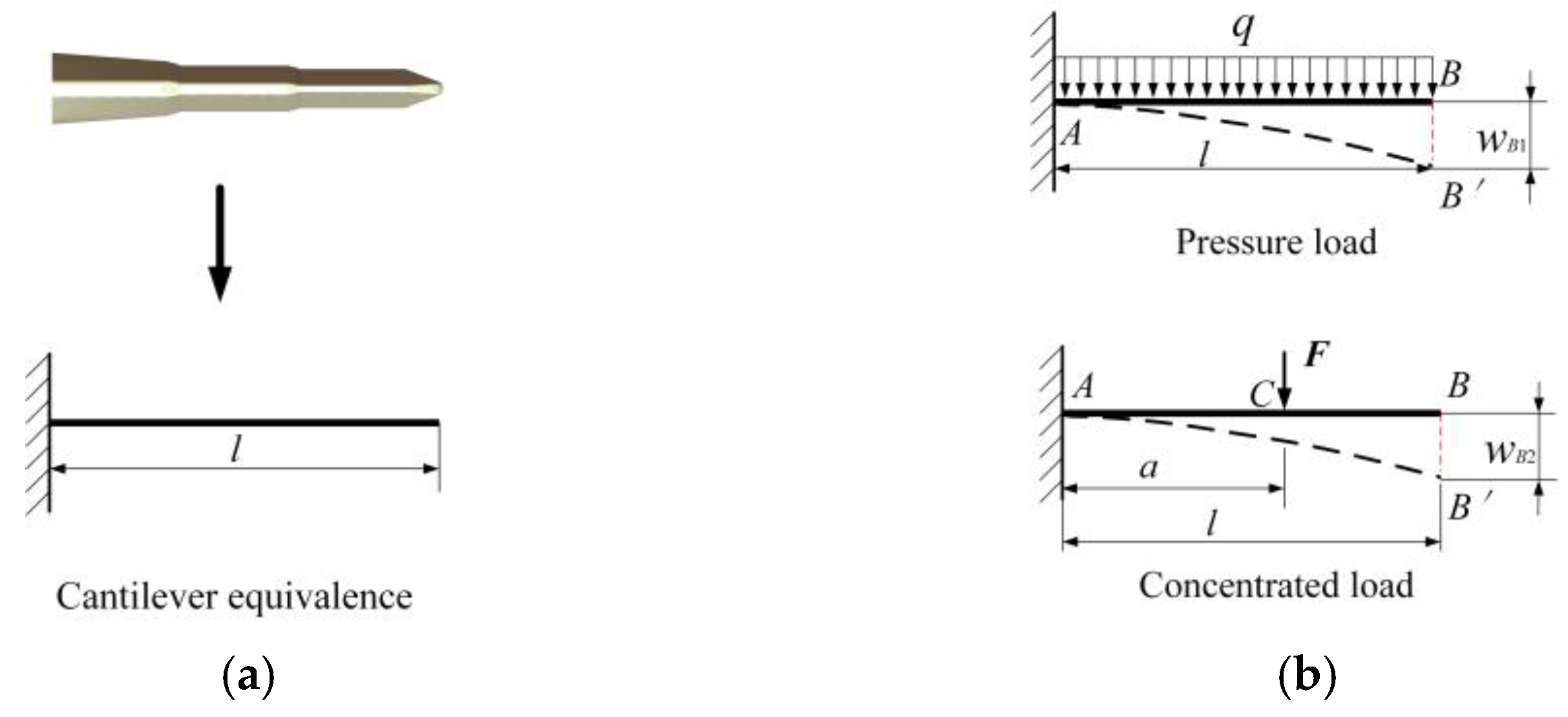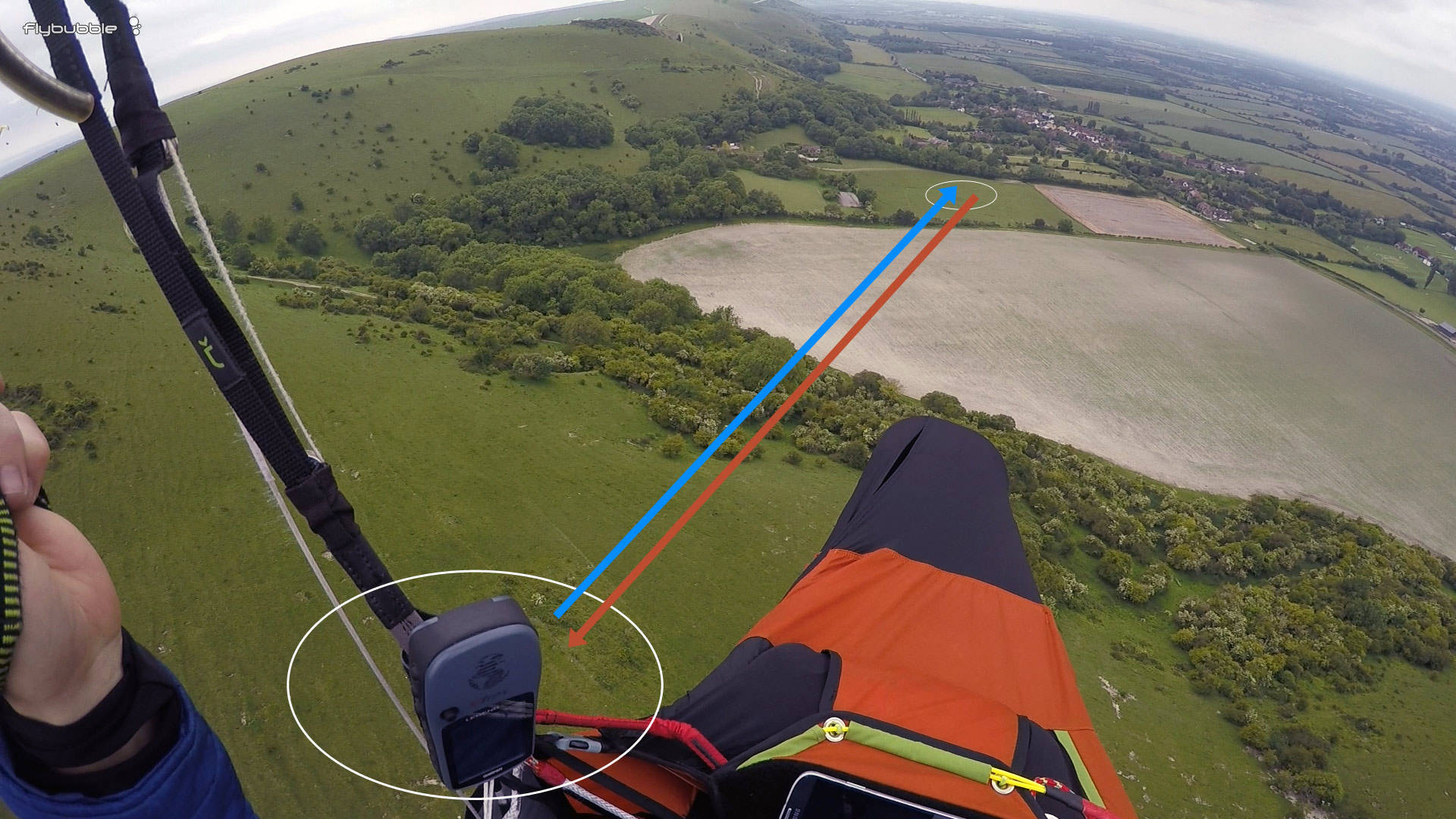Optimize Your Glider's Performance
Calculate your wing loading with precision to enhance handling, safety, and thermalling efficiency for sailplanes, hang gliders, and paragliders.
Try Our Calculator
Calculate your wing loading with precision to enhance handling, safety, and thermalling efficiency for sailplanes, hang gliders, and paragliders.
Try Our Calculator
Wing loading is one of the most critical parameters in glider performance, affecting everything from stall speed to thermalling efficiency. It represents the relationship between the total weight of your aircraft (including pilot, gear, and any ballast) and the surface area of the wings.
At Gliders Haven, we've developed a precise wing loading calculator to help pilots of all experience levels optimize their setup. Whether you're flying a high-performance sailplane, a flexible hang glider, or a responsive paraglider, understanding your wing loading is essential for safe and efficient flight.
Our calculator supports both metric (kg/m²) and imperial (lbs/ft²) measurements, making it accessible to pilots worldwide. The tool accounts for all components of your flight system - the glider itself, your body weight, flight gear, and any additional ballast you might be carrying for different weather conditions.
Proper wing loading affects several flight characteristics: higher loading increases penetration in strong winds but may make thermalling more challenging, while lower loading improves climb performance in weak conditions but reduces high-speed stability. Our calculator helps you find that perfect balance for your flying style and conditions.
Beyond basic calculations, we provide context about what your numbers mean in practical terms, helping you make informed decisions about ballast and equipment choices. Whether you're preparing for a competition flight or just enjoying recreational soaring, our wing loading calculator is an indispensable tool in your pre-flight planning.
Our calculator uses advanced algorithms to provide accurate wing loading values in both metric and imperial units, ensuring reliable results for all pilots worldwide.
Determine the ideal amount of ballast for different weather conditions to maximize performance while maintaining safe handling characteristics.
Understand how your wing loading affects stall speed, glide ratio, thermalling ability, and penetration in various wind conditions.
Works with all types of gliders including sailplanes, hang gliders, and paragliders, making it a versatile tool for all soaring enthusiasts.
Access our calculator from any device at the airfield or during pre-flight planning, with a responsive design that works perfectly on smartphones and tablets.
Comprehensive explanations and typical value ranges help both novice and experienced pilots better understand wing loading implications.
Before using the calculator, you'll need two key pieces of information:
Enter your values into the calculator fields:
Our calculator automatically handles the conversion between units, so you can mix metric and imperial measurements if needed.
After clicking "Calculate Wing Loading," you'll receive your wing loading value along with interpretation:
Use your calculated wing loading to make informed decisions:
For regular use, consider creating weight profiles for different configurations (competition, recreational, training) to quickly calculate wing loading for various scenarios. Many pilots find it helpful to keep a record of their wing loading under different conditions to better understand their glider's performance across a range of situations.

Explore the fundamental relationship between wing loading and flight characteristics in this comprehensive guide.
Read More →
Learn professional techniques for optimizing ballast based on weather conditions and competition requirements.
Read More →
Understand how wing loading principles apply differently to sailplanes, hang gliders, and paragliders.
Read More →
Master the art of thermalling by adapting your technique to your specific wing loading situation.
Read More →Critical safety information every pilot should know when flying with increased wing loading.
Read More →
How wing loading trends have changed in high-performance sailplanes over the decades.
Read More →
Competition Sailplane Pilot
"Using the Gliders Haven wing loading calculator transformed my competition strategy. By precisely calculating my optimal ballast for different conditions, I improved my cross-country speeds by 12% and won my first national championship. The ability to quickly adjust my calculations at the airfield based on changing weather was invaluable."

Hang Gliding School Owner
"As an instructor, I recommend Gliders Haven's calculator to all my students. It helps them understand the critical relationship between weight and wing area in a tangible way. We've seen a noticeable improvement in student confidence and decision-making since incorporating this tool into our training program. The clear explanations of how wing loading affects handling are particularly helpful for new pilots."

Paragliding Expedition Leader
"When planning high-altitude expeditions, precise wing loading calculations are crucial for safety. Gliders Haven's tool helped me optimize my equipment choices for different mountain ranges. The ability to quickly convert between units is especially useful when coordinating with international team members. This calculator has become an essential part of my pre-flight checklist."
Our wing loading calculator uses advanced algorithms developed by competition pilots and aerospace engineers to provide the most accurate results possible. We account for subtle factors that other calculators ignore, giving you confidence in your pre-flight planning.
Unlike basic calculators that just give you a number, we provide detailed interpretation of what your wing loading means for actual flight performance. Our recommendations are tailored to your specific type of glider and flying conditions.
Created by pilots for pilots, our tool addresses real-world needs you encounter at the airfield. The interface is optimized for quick, stress-free calculations even when you're preparing for an imminent launch.
Whether you fly sailplanes, hang gliders, or paragliders, our calculator adapts to your needs. We understand the unique characteristics of each glider type and provide appropriate guidance for each.
Our extensive library of articles, tutorials, and reference materials helps you deepen your understanding of aerodynamics and flight performance. We're committed to helping you become a more knowledgeable pilot.
Used by national and world champions in multiple disciplines, our tools have been proven in the most demanding competitive environments. When performance margins are measured in seconds, champions trust Gliders Haven.
While our calculator provides precise technical information, we always emphasize that safe flying decisions consider many factors beyond wing loading. We strongly recommend using our tool as part of comprehensive pre-flight planning that includes weather assessment, equipment checks, and personal readiness evaluation. Safety always comes before performance.
Join thousands of pilots who trust Gliders Haven for precise wing loading calculations and performance optimization.
We'll send you occasional gliding tips and tool updates. No spam, ever.